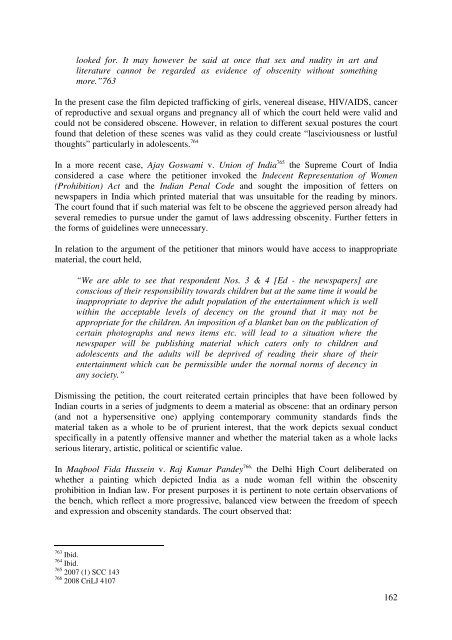SEXUAL HEALTH AND HUMAN RIGHTS A legal and ... - The ICHRP
SEXUAL HEALTH AND HUMAN RIGHTS A legal and ... - The ICHRP
SEXUAL HEALTH AND HUMAN RIGHTS A legal and ... - The ICHRP
Create successful ePaper yourself
Turn your PDF publications into a flip-book with our unique Google optimized e-Paper software.
looked for. It may however be said at once that sex <strong>and</strong> nudity in art <strong>and</strong><br />
literature cannot be regarded as evidence of obscenity without something<br />
more.”763<br />
In the present case the film depicted trafficking of girls, venereal disease, HIV/AIDS, cancer<br />
of reproductive <strong>and</strong> sexual organs <strong>and</strong> pregnancy all of which the court held were valid <strong>and</strong><br />
could not be considered obscene. However, in relation to different sexual postures the court<br />
found that deletion of these scenes was valid as they could create “lasciviousness or lustful<br />
thoughts” particularly in adolescents. 764<br />
In a more recent case, Ajay Goswami v. Union of India 765 the Supreme Court of India<br />
considered a case where the petitioner invoked the Indecent Representation of Women<br />
(Prohibition) Act <strong>and</strong> the Indian Penal Code <strong>and</strong> sought the imposition of fetters on<br />
newspapers in India which printed material that was unsuitable for the reading by minors.<br />
<strong>The</strong> court found that if such material was felt to be obscene the aggrieved person already had<br />
several remedies to pursue under the gamut of laws addressing obscenity. Further fetters in<br />
the forms of guidelines were unnecessary.<br />
In relation to the argument of the petitioner that minors would have access to inappropriate<br />
material, the court held,<br />
“We are able to see that respondent Nos. 3 & 4 [Ed - the newspapers] are<br />
conscious of their responsibility towards children but at the same time it would be<br />
inappropriate to deprive the adult population of the entertainment which is well<br />
within the acceptable levels of decency on the ground that it may not be<br />
appropriate for the children. An imposition of a blanket ban on the publication of<br />
certain photographs <strong>and</strong> news items etc. will lead to a situation where the<br />
newspaper will be publishing material which caters only to children <strong>and</strong><br />
adolescents <strong>and</strong> the adults will be deprived of reading their share of their<br />
entertainment which can be permissible under the normal norms of decency in<br />
any society.”<br />
Dismissing the petition, the court reiterated certain principles that have been followed by<br />
Indian courts in a series of judgments to deem a material as obscene: that an ordinary person<br />
(<strong>and</strong> not a hypersensitive one) applying contemporary community st<strong>and</strong>ards finds the<br />
material taken as a whole to be of prurient interest, that the work depicts sexual conduct<br />
specifically in a patently offensive manner <strong>and</strong> whether the material taken as a whole lacks<br />
serious literary, artistic, political or scientific value.<br />
In Maqbool Fida Hussein v. Raj Kumar P<strong>and</strong>ey 766, the Delhi High Court deliberated on<br />
whether a painting which depicted India as a nude woman fell within the obscenity<br />
prohibition in Indian law. For present purposes it is pertinent to note certain observations of<br />
the bench, which reflect a more progressive, balanced view between the freedom of speech<br />
<strong>and</strong> expression <strong>and</strong> obscenity st<strong>and</strong>ards. <strong>The</strong> court observed that:<br />
763 Ibid.<br />
764 Ibid.<br />
765 2007 (1) SCC 143<br />
766 2008 CriLJ 4107<br />
162

















